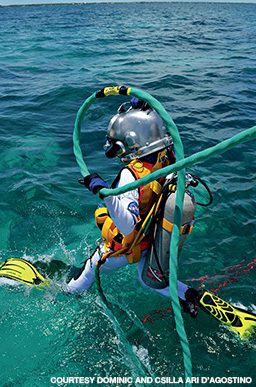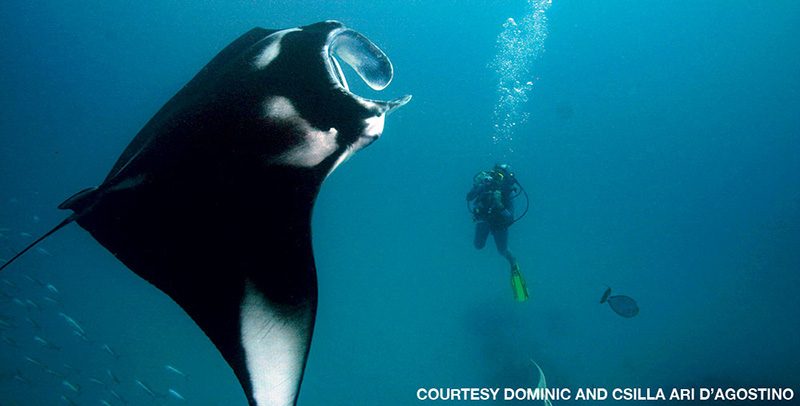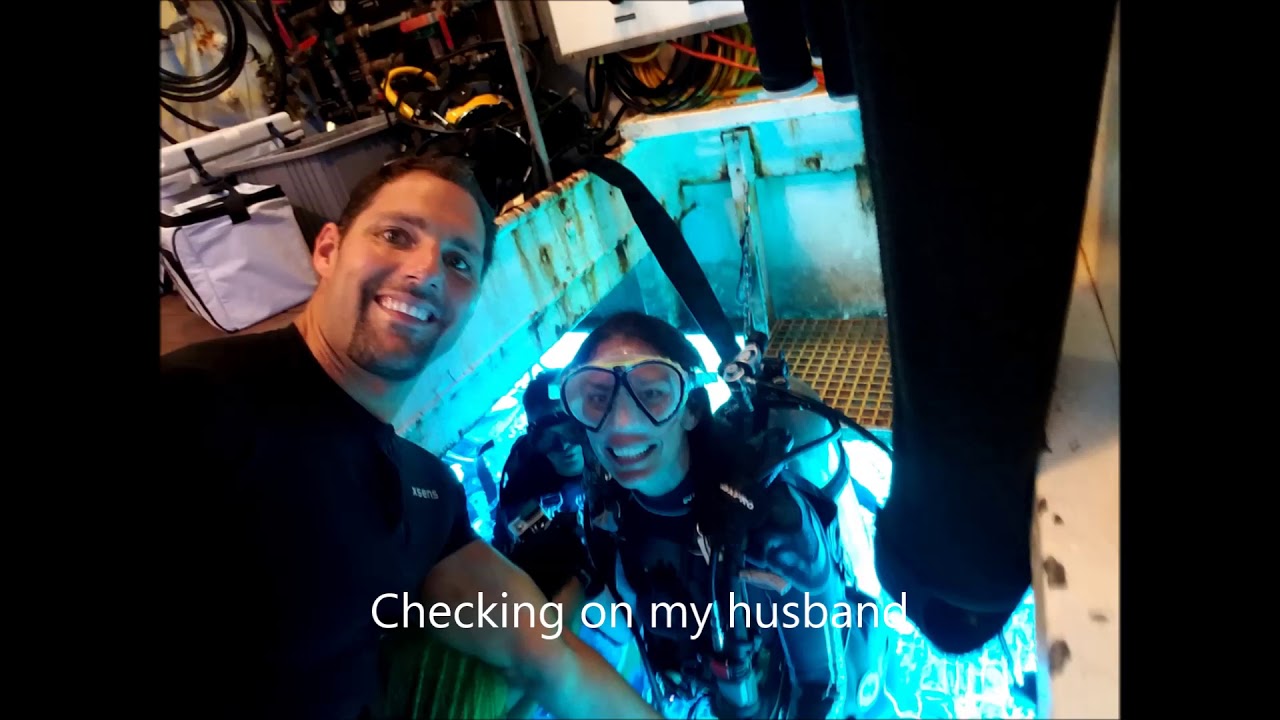Energetic dive research from Florida
Based at the University of South Florida (USF) in Tampa, Csilla Ari D’Agostino, Ph.D., works in the department of psychology, and her husband, Dominic D’Agostino, Ph.D., is in the department of molecular pharmacology and physiology. These enthusiastic researchers and divers have just returned from a NASA Extreme Environment Mission Operations (NEEMO) research and exploration mission at the Aquarius Reef Base habitat, an underwater laboratory to train astronauts and undertake unique research such as simulated spacewalks, called extravehicular activities, while in saturation.
In this nine-day NEEMO 23 mission, Csilla lived in the habitat and conducted 10 research projects with their team. These studies included tests to assess changes in the participants’ cognitive abilities such as short-term memory, problem-solving, decision-making and reaction time, as well as motor function and digital dexterity, changes in grip strength, heart rate, sleep duration and quality (a major risk factor for human error), stress levels, team cognition, blood markers, body composition and microbiome during their stay. Csilla also did underwater work for her National Geographic Open Explorer projects using a remotely operated vehicle. Dominic was a crew member on the previous NEEMO 22 mission, so they are certified long-duration saturation divers, also known as aquanauts.

When you are not in a saturated underwater environment, what is your research focus at USF?
Dominic: I have been working on developing and testing ketogenic diets and supplements for several years. The ketogenic diet was introduced in the early 1920s to prevent seizures in epileptic patients at the Mayo Clinic; it was later adapted by many other well-known clinics and has become a success story for more than just epilepsy. Emerging studies suggest that the ketogenic diet has therapeutic potential for oxygen toxicity seizures, some neurodegenerative disorders, metabolic disorders such as type 2 diabetes and even as an adjuvant to cancer therapy. It is by no means a wonder drug or panacea, but emerging science supports that metabolic changes associated with the ketogenic diet can have numerous effects on general health and even longevity.
What is a ketogenic diet?
Dominic: The body (for humans as well as animals) relies on energy from food intake. The fastest energy option is sugar from stored carbohydrates (glycogen), which is used to fuel brain energy metabolism and muscle contraction. When we actively cut sugars and starches from our diet, the body burns fat from dietary fats and stored body fat. High rates of fat burning stimulate the production of ketone bodies (beta-hydroxybutyrate, acetoacetate and acetone), which we can measure in blood, urine and breath, respectively. Ketones represent an alternative fuel for the brain, and they also have powerful neuroprotective signaling properties.
Starvation or intermittent fasting are radical ways to push our physiology into ketosis, but nutritionally healthy ketosis can be achieved only with sustained adherence to a well-formulated ketogenic diet.
How does it feel when going into ketosis?
Dominic: It is specific to the individual. Some people have an intolerance to high fat intake, and ketogenic diets typically contain more than 70 percent fat. The ketogenic switch can take several days to weeks and might result in an initial feeling of nausea or even lethargy. The upside is that people in the state of ketosis (a defined level of ketones measured in blood, urine or breath) describe having more energy and feeling more lucid, and many individuals experience reduced weight and can sustain weight loss due to the diet’s appetite-suppressing effects.

Is there scientific proof for this?
Dominic: Yes, the ketogenic diet is one of the few diets in which the physiological effect can be directly measured by a commercially available device (and we’re not talking about body weight scales). Several manufacturers sell blood ketone meters that are available online or in retail stores. If ketone bodies in one of the measurable areas (blood, urine or breath) are elevated, this confirms that the individual is on the right track. The ketogenic diet is the only diet that is clearly defined by the elevation of an objective biomarker (ketones). While some people follow this diet explicitly for weight loss, considering all the other positive effects on the body might relegate weight loss to being a beneficial side effect.
Thousands of publications on PubMed support what I have described, and the emerging science is continuing to go beyond that. With funding from the Office of Naval Research (ONR), we have investigated ketones, the diet and supplements for several years.
The U.S. Navy became interested in ketones as a preventive measure for oxygen toxicity associated with closed-circuit rebreathers used by the Navy SEALs and others in the special operations forces. Experiments designed to evaluate the therapeutic efficacy of ketone supplements and the ketogenic diet are still ongoing at USF in collaboration with Duke University; despite the clinical results being preliminary, the future direction of this research looks promising.
Csilla: Another interesting aspect we observed comes from numerous animal studies. In multiple rodent models we found that the ketogenic diet or ketogenic agents protected against anesthetic gases and had an anxiolytic effect. Further experiments included the ketogenic diet’s anti-inflammatory capacities and the effect on breath-hold performance. We now know that ketone bodies are strong signaling molecules that can regulate gene expression in ways that could promote protective effects for days or weeks, even after ketosis stops.

How could this relate to diving?
Dominic: Central nervous system oxygen toxicity limits the depth and operational time for divers breathing high-pressure oxygen, especially Navy SEALs using closed-circuit rebreathers. The technical diving community is interested in the effects of oxygen on the body and in the potential risks of oxygen toxicity. The question from that community is how to mitigate these risks while diving. We started working with the ONR to determine if ketosis might prevent oxygen toxicity. To circumvent the dietary restrictions associated with the ketogenic diet, we had developed and tested ketogenic compounds, including ketone esters. Several of these agents offered a high level of neuroprotection against oxygen toxicity and anesthetic gases.
Csilla: We observed that the rats fed certain ketogenic agents resisted the effect of anesthesia, implying neuroprotective properties. As nitrogen narcosis has similarities to anesthesia when looking at the mechanisms in the brain, it is possible that some of these agents could mitigate or reduce the effects of nitrogen narcosis, but further studies are needed to test this hypothesis. The ketogenic compounds also had anxiolytic effects that can be beneficial when diving in high-stress environments or can help achieve better oxygen consumption.
Can anyone follow a ketogenic diet?
Dominic: Anyone can, but certainly not everyone should. Many resources are available online that describe ketogenic meal plans and the efficacy of ketone supplements. Getting into nutritional ketosis will take at least a few days, so it is not ideal to start the diet the day before a dive trip. The body needs time for keto-adaptation, a metabolic transition phase that occurs rapidly in some individuals and more slowly in others.

The ketogenic diet seems to affect oxygen toxicity and possibly nitrogen narcosis. While these are certainly interesting topics, dive science remains heavily focused on decompression sickness (DCS). Is there any research on the impact of a ketogenic diet on DCS?
Dominic: Not yet, but it would be interesting to see the effect of this diet on decompression stress, which is associated with changes (e.g., inflammation) that may be responsive to therapeutic ketosis. We plan to study the effect of a ketogenic diet in an environment with significantly higher carbon dioxide levels. We know that oxygen toxicity, which influences oxidative stress, is a function of oxygen exposure and carbon dioxide levels.
Tell us about your marine biology research.
Csilla: Whenever possible I conduct studies on the neuroanatomy and behavior of manta rays. A surprising fact I found during my studies is that these animals have the largest brain of all fish species. I also found that ketone levels in manta rays are extremely high. This might be useful for protecting and maintaining their brain function during deep dives of more than 3,000 feet.
Coming from the psychological research side, you are also interested in the behavior of manta rays. Tell us about that.
Csilla: The black-and-white coloration and patterns of manta rays are considered permanent and are used to identify and monitor individual animals to get a better understanding of the population sizes and their travel routes. When I observed mantas in captivity (in aquariums), I found that the white patterns on their back can drastically change in intensity within minutes during feeding time or intense social interactions or when a new manta was introduced into the tank. I also observed that the ventral pigmentation changed over a couple of months.
These findings are published, but the reason for these pattern changes remains largely unknown. It might indicate a state of arousal or excitement, or it may be a communication signal as part of their social behavior. It is important to question why it happens for other reasons, e.g., during maturation or as a reaction to environmental changes. In the worst case it could mean that we are overestimating the population sizes of these gentle giants.

Other Research
Aside from their work at USF, Dominic and Csilla started a company called Ketone Technologies that supports research in fields that are not in USF’s direct focus. Both scientists spend a lot of time on their research, are well-respected in their fields and get frequent inquiries to speak publicly or write about their research. Follow Csilla’s work at csillaari.com. Find more information about ketones, the ketogenic diet and the science behind them at ketonutrition.org.
What’s Next?
Dominic and Csilla plan to publish findings from the vast amount of data from the NEEMO mission and prepare for the next missions into extreme environments. With so much to be discovered, this enthusiastic couple is devoted to their underwater and hyperbaric research, be it about manta rays, nutrition or extreme environments.
Explore More
Learn more about Ketone Technologies in this video.
© Alert Diver — Q4 2019

